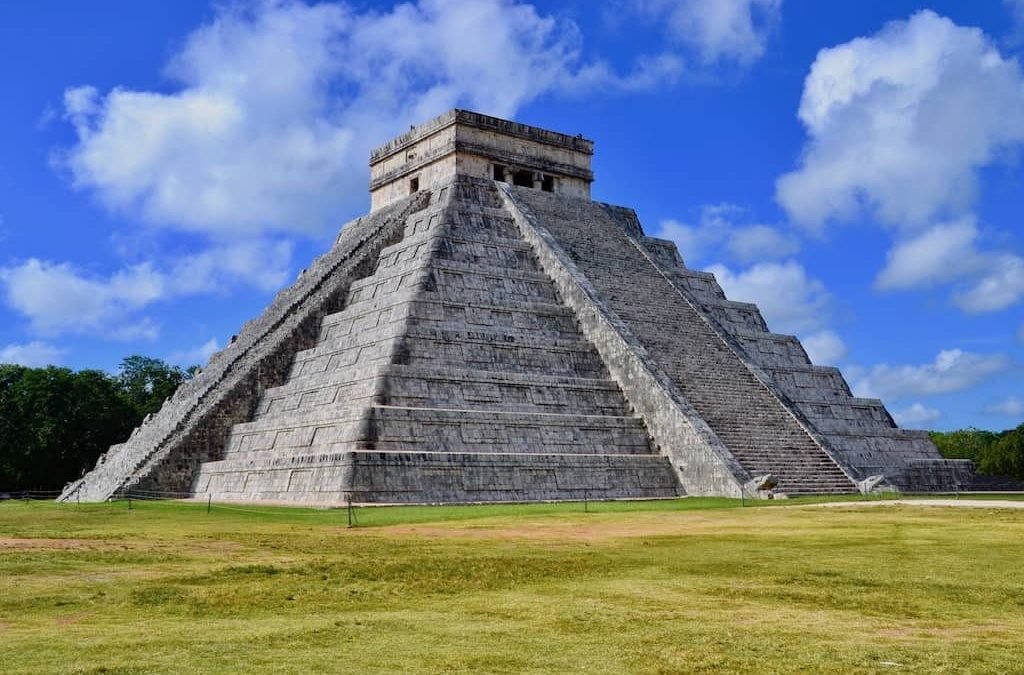Top 50 Unknown and Interesting Facts About Chichen Itza
Chichen Itza, one of the most well-known archeological monuments of the ancient Maya civilization, is situated in Mexico’s Yucatan Peninsula. One of the New Seven Wonders of the World, it is a UNESCO World Heritage site that displays the advanced architectural design, astronomical knowledge, and cultural customs of the Maya people. Chichen Itza was established in the 7th century and remained a significant political, commercial, and religious hub until the 10th century.
El Castillo, sometimes called the Temple of Kukulkan, is the most recognizable building on the property. The exact geometry of this pyramid-shaped building corresponds with astronomical occurrences; on equinoxes, a shadow that resembles a serpent descending from the top of the pyramid emerges on the stairs, representing Kukulkan, the feathered serpent deity. This incident demonstrates the remarkable mathematical and astronomical knowledge of the Maya.

Other intriguing buildings can be seen in Chichen Itza, such as the Sacred Cenote, the Great Ball Court, and the Temple of the Warriors. Ancient Maya played their customary ball game, which was as much a sacred rite as a pastime, on the Great Ball Court, the biggest in Mesoamerica. Archaeologists have discovered artifacts and human remains at the Sacred Cenote, a natural sinkhole that served as a location for offerings to the gods.
The architectural skill, social structure, and religious fervor of the Maya culture are all exemplified in this ancient city. Millions of tourists visit there each to explore the mystery and history of one of Mesoamerica’s finest cities, and it is still a well-liked tourist site today.
Let’s dive into some lesser-known, yet captivating facts about this UNESCO World Heritage Site.
1. Ancient Center of the Maya Civilization
- Chichen Itza was a major city of the Maya civilization and served as an important political, economic, and religious center during the Classic and Postclassic periods.
2. Named After Sacred Cenotes
- The name “Chichen Itza” roughly translates to “At the mouth of the well of the Itza.” This refers to the nearby cenotes (natural wells) that were vital for the city’s water supply and religious rituals.
3. One of the New Seven Wonders of the World
- Chichen Itza was designated as one of the New Seven Wonders of the World in 2007, joining the ranks of landmarks like the Great Wall of China and Machu Picchu.
4. Home to the Kukulkan Pyramid
- Also known as “El Castillo,” the pyramid of Kukulkan is the most iconic structure in Chichen Itza, standing at nearly 30 meters tall.
5. Equinox Shadow Phenomenon
- During the spring and autumn equinoxes, the pyramid casts a shadow that resembles a serpent slithering down the steps, symbolizing the feathered serpent god Kukulkan.
6. One of the Largest Ball Courts
- Chichen Itza boasts one of the largest ball courts in Mesoamerica, where the ancient Maya played a ritual ball game that often had ceremonial significance.
7. The Great Ball Court Acoustics
- The acoustics of the Great Ball Court are engineered so that sounds made at one end can be heard clearly at the other end, 150 meters away.
8. Maya Astronomy and Mathematics
- The structures of Chichen Itza were designed to reflect Maya expertise in astronomy and mathematics, with precise alignments to the sun and celestial bodies.
9. Built by Diverse Cultures
- Chichen Itza showcases a blend of Maya and Toltec architectural styles, indicating influences from both civilizations in its construction.
10. Human Sacrifice at Sacred Cenote
- The Sacred Cenote was used for sacrificial rituals, where valuable items and even human offerings were cast into the water to appease the gods.
11. The Temple of Warriors
- This large, stepped pyramid is flanked by columns carved with warrior figures, representing the militaristic society of the time.
12. The Observatory: El Caracol
- Known as El Caracol (“the snail”), this circular structure is believed to have served as an observatory for tracking the movements of Venus.
13. Hundreds of Buildings Once Existed
- While today only a few structures remain visible, Chichen Itza once had hundreds of buildings across its vast landscape.
14. Alignment with Celestial Events
- The orientation of many structures is aligned with important celestial events, like solstices and equinoxes, underscoring the Maya’s astronomical prowess.
15. Maya Calendar Reflected in El Castillo
- El Castillo is a symbolic calendar, with 365 steps (one for each day), 52 panels (representing the Maya century), and 18 terraces (signifying the months in the Maya calendar).
16. Temple of the Jaguars
- This smaller temple near the Great Ball Court features murals and carvings of jaguars, a revered animal in Maya culture.
17. Mysterious Alignment with Other Sites
- Chichen Itza aligns with other ancient Mesoamerican sites, hinting at the existence of trade routes and alliances.
18. Rediscovered by John Lloyd Stephens
- Although abandoned centuries earlier, Chichen Itza was “rediscovered” and popularized by American explorer John Lloyd Stephens in the 19th century.
19. Symbol of Rebirth
- The Kukulkan Pyramid’s serpent shadow during the equinox represents rebirth and renewal in Maya beliefs.
20. The Temple of Skulls
- The Tzompantli (Temple of Skulls) is a platform decorated with carvings of skulls, where the Maya displayed the heads of sacrificial victims and enemies.
21. Advanced Water Management
- The cenotes provided a reliable water source, and the Maya developed sophisticated water management systems to support the large population.
22. Religious Pilgrimage Site
- Chichen Itza was a pilgrimage destination for the Maya, who came to worship and perform ceremonies.
23. Influence of Venus in Maya Culture
- Venus held great significance in Maya culture, and many Chichen Itza structures are oriented toward the planet’s movements.
24. The Red House
- The “Casa Colorada” or Red House is named for the red pigments found on its walls, and it served as an administrative building.
25. Temple of the Bearded Man
- This temple has a carving that resembles a bearded man, a feature uncommon in Maya art, leading to various theories about outside influences.
26. Residential Buildings for the Elite
- The elite Maya families and priests lived in residential complexes within the city, with evidence of ornate decoration and comfortable living spaces.
27. Architectural Precision
- The city’s layout and architectural precision are attributed to Maya expertise in building techniques without metal tools or modern technology.
28. Rich Symbolism of the Serpent
- The serpent motif, especially prominent in Kukulkan, symbolizes power, spirituality, and the duality of life and death in Maya mythology.
29. Use of Lintels in Doorways
- Many doorways in Chichen Itza are decorated with carved lintels, providing insights into the city’s religious and political life.
30. The Thousand Columns Group
- This structure was once a large colonnaded hall with over a thousand columns, suggesting it was a gathering place for community events or markets.
31. The Maya Underworld
- The Maya believed cenotes connected to Xibalba, the underworld, making them powerful spiritual sites.
32. Unique Architecture of Nunnery Complex
- The “Nunnery” building complex features elaborate stone carvings and symbols, though its purpose is still uncertain.
33. Population Estimates
- Archaeologists estimate Chichen Itza may have housed tens of thousands of people at its peak, making it one of the most populous cities of its time.
34. Chichen Itza’s Decline
- The city was mysteriously abandoned in the 13th century, though its decline remains a topic of debate among historians.
35. Craftsmanship in Chac Mool Sculptures
- Chac Mool sculptures are distinctive reclining figures that held offerings, representing messengers to the gods.
36. Worship of Chaac, the Rain God
- Chaac, the Maya rain god, was highly revered, and offerings were made to ensure sufficient rainfall.
37. The High Priest’s Grave
- This pyramid served as a burial site for Maya priests and was adorned with intricate carvings and stonework.
38. Tzolk’in Calendar Symbolism
- The layout of Chichen Itza reflects the Tzolk’in calendar, a 260-day ritual cycle in the Maya calendar system.
39. Hypothesis of Foreign Invasion
- Evidence suggests that the Toltecs from Central Mexico may have invaded and influenced Chichen Itza, which is reflected in its art and architecture.
40. Mystery of the Construction Techniques
- The Maya constructed these complex structures without the wheel or iron tools, a feat that remains puzzling to historians.
41. Connection to Astronomy and Agriculture
- The Maya designed buildings to align with agricultural cycles, as astronomical events dictated the timing of planting and harvesting.
42. Centralized Government System
- Chichen Itza had a centralized government, which was uncommon among Maya city-states, hinting at a different societal structure.
43. Sculptures of Eagles and Jaguars
- Carvings of eagles and jaguars, symbols of power and the warrior class, can be seen throughout the city.
44. Stone Carving Artistry
- Chichen Itza’s artisans were skilled in stonework, creating detailed carvings that depicted mythological and historical events.
45. Reverence for the Number Nine
- The number nine, associated with the underworld, is featured in several structures, symbolizing the journey of the soul after death.
46. Temple of Venus
- A temple dedicated to the planet Venus underscores the Maya’s devotion to astronomical deities and their belief in Venus’s influence on war.
47. Legacy of Maya Hieroglyphics
- The hieroglyphic inscriptions at Chichen Itza offer valuable insights into Maya history, politics, and mythology.
48. Influence on Modern Maya Culture
- The legacy of Chichen Itza endures in modern Maya culture, with descendants continuing to honor many ancient customs.
49. Role in Tourism and Economy
- Chichen Itza is one of the most visited sites in Mexico, contributing significantly to the local economy and cultural tourism.
50. Preservation and Ongoing Research
- The Mexican government and international organizations are dedicated to preserving Chichen Itza, as research continues to uncover more about this ancient marvel.

